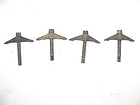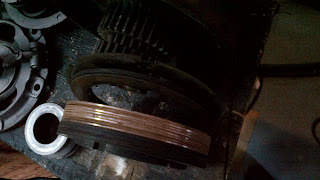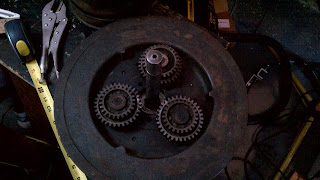Engine:
It's been a while since my last post and in that time I have done a lot of reading and research.
I decided to refocus my energy on the engine and transmission. I have been stalking ebay sellers for the last few months and have purchased some essential parts for the motor and transmission.
To recap - I basically started out with an engine block, cylinder heads, valves, crankshaft and an engine head.
I was able to purchase engine parts from a 1919 Ford model T TT ( this was the truck model, but it used the exact same engine) from a salvage yard in northern Michigan. These parts included:
Manifold
Manifold intake
Manifold studs
Manifold clips and bolts
Engine head
Engine valve cover plates
Transmission hog's head
I also purchased water Inlet/outlets for both the engine/head, a vaporizer and Kingston L carburetor for stores in Illinois and Kansas.
What's great about all these buys is the parts are all original. Most of the parts I have sanded/repainted with a high heat tremclad enamel paint that is resistance up to 650 degrees.
These are the parts I purchased in Michigan (before painting):
Transmission door, engine valve plates:
Engine Head:
Manifold clamps:
Manifold & below that the intake Manifold:
Transmission Hogs head:
Vaporizer :
Kingston L Carburetor:
Here's the engine plates with the paint I am using. The function of these plates is cover the cylinder valves on the left side of the engine. Essentially you can take these off to allow easy access to adjust the valves as needed. Each cylinder has two valves, four per side intake/exhaust.
Here's a pic of the engine block with the plates off, you will notice the valves with the springs on them. The plates cover the valves with a gasket to seal the compartment.
Here is the "almost" completed left side of the engine. On the top right side of the engine head you will notice a round cylinder pointing up. This is the water inlet that is connected to the rad. The long bar at the top of the engine is the manifold, then below is the intake manifold and you will notice that the valve covers have been installed. All three items were sanded down and painted. The carburetor will attach to the intake manifold and you can see a small bolt on the engine block near the base of the intake manifold. This bolt is where the side of the carburetor will attach to the block.

Unfortunately I don't have the carburetor here yet, it's on it's way from Kansas and should be at my house in the next week, but I do have a picture. This is the actual one I have purchased, and is correct for the 1914 model year. Depending on the time of year and inventory levels at the ford plant a Model T could have come with this carb or a New Holly carb. I have read quite a few opinions on which carb is better or worse, it seems that people are either in one camp or the other. I bought the Kingston mainly because the L carburetor is specific to the year and this one is in great shape. I haven't seen any other carbs (Kingston or Holly) that are in as great of a condition as this one. The right side of the carb attaches to the intake manifold the left side is the throttle which attaches to the vaporizer. The top black button will be connected to a rod that sits on the firewall in the front seat of the car. The base of carb is where the fuel line is attached to.
Transmission:
The transmission is probably the part of this car that scares me the most. I have really been avoiding it for the past year. A few months ago I started reading up on it, and I feel like I have a pretty good understanding of it. It's still a complicated piece of the puzzle, but at the very least I know how it works and I have almost all the parts.
What were looking at here is the flywheel with magneto. As you notice in the picture there are some screws stuck to the flywheel because its full of magnets. When the flywheel turns the magnets charge the ignition coils which create spark to ignite the engine. So when you crank start the engine, it's turning the flywheel and the magnets to charge the coils to create spark. In the centre of the wheel you will notice four holes, these attach to the drive wheel which attaches to the crankshaft on the engine:
Here's an upside down view of the engine, the metal circle coming out of the crankshaft is where the flywheel connects. The other side of the engine is the front, where the crank start will be. When the crankshaft is moving the cylinder heads move up and down creating power. The reason you will see the long screws attached to the drive plate is earlier that day I had the flywheel attached and was using it to turn the crankshaft.
Here's a side view of the flywheel with the gear shaft. The three gears attach to the gear shaft:
I found a seller in Mahah, Nj who was selling old stock of transmission parts. The parts were never used, they were made by a gentleman who remanufactured parts for Ford and other antique car dealers. I didn't really get the story on what happened to him or his business. I did however get some much need parts for my transmission. Most of the parts I needed were related to the clutch but heres a rundown of what I got:
Clutch spring and support
Clutch push ring
Clutch plate with fingers
Clutch shift collar
I also purchased transmission bands from a dealer in Illinois.
Looking at the below pic, (starting from the bottom up) you have three gears, reverse, low & brake drum. The middle silver parts are all the new parts I purchased. The drive shaft connects at the top end.
Here they are all laid out.
This is a pic of the flywheel, the magnets you saw before on the other side. The three gear drums connect over the gear shaft and connect with the three gears on the flywheel.
Here is a picture of the transmission bands I purchased. These bands are placed around the gear drums and are tightened with the pedals that are attached to the hogs head.
The below two pics are completed transmissions. Pic one shows the bands around the drums and pic 2 shows a complete transmission attached to engine.
In my next post I will give a more detailed account of how all these parts work together.
My new goal for 2013 is to get this engine running on New years eve of 2013/2014. This will mark the 100th year of the car.
Happy New year everyone!!!
















































